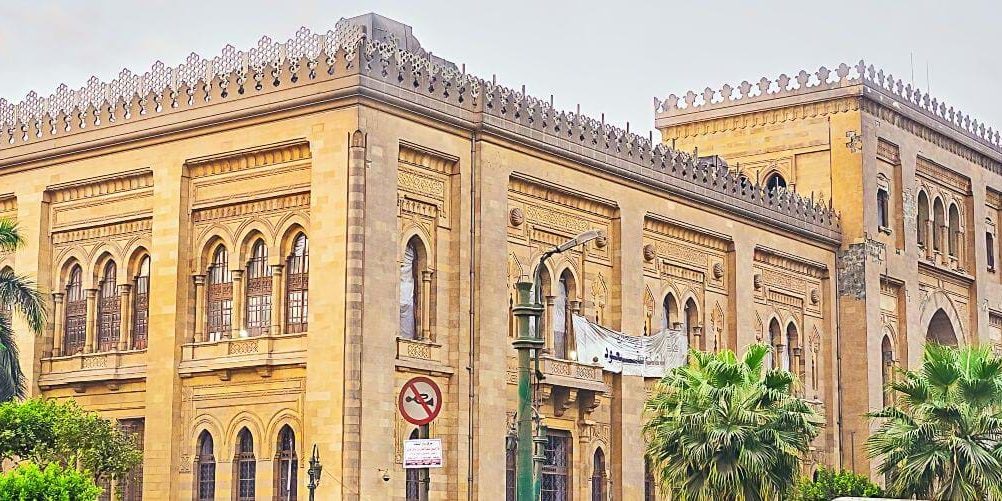Egypt has witnessed the early rise of the Christian era. In fact, the country was a shelter where the holy family took refuge in some places erected now as popular monasteries and churches. After the Christian Coptic period, the Islamic conquest happened in 642 A.D, and Egypt was declared officially as Islamic country and should use Arabic as its official language. However, the Christians religion and Coptic culture remained still in Egypt, and the churches rang their bells every Sunday. Muslims started to build principal architectural types of mosques, palaces and forts in Egypt, and the first was Amr bin El Aas mosque which contained religious art elements.
Islamic art
Islamic art can be identified from the recurrent motifs of floral, geometric and vegetal shapes. The sequence of repeating these shapes is called “arabesque” which can be seen in most of old Islamic mosques and architectures. The beginning of the Islamic art was influenced by the Romans and bezants whom the Muslims conquered their countries in the 7th and 8th centuries, and that’s why you can find secular elements in Islamic art as well. Later, it was developed through many stages during the Umayyad, Abbasid and Ottoman periods until it was basically characterized by overusing geometric, abstract floral and calligraphic (the art of Arabic handwriting).
The Islamic artists were exceptional in wood and plaster artifacts beside carpets, silk, glass and crystal objects. All of these artworks were gathered under the commandment of khedive Tewfik from the Islamic world to be preserved and displayed in the museum of Islamic art. If you are interested to visit the museum and check out the legendary Islamic collection, book one of Cairo day tours to visit old Cairo and its distinguished highlights included the museum or you can customize your trip and involve the museum within the itinerary you like.
The museum of Islamic art
Islamic art features recurring motifs such as floral, geometric, and vegetal shapes. These patterns, known as “arabesque,” appear in many old Islamic mosques and architectural designs. Initially, Islamic art was influenced by the Romans and Byzantines, whose territories Muslims conquered in the 7th and 8th centuries. Consequently, secular elements can also be found in Islamic art. Over time, Islamic art evolved through the Umayyad, Abbasid, and Ottoman periods. It became characterized by its geometric, abstract floral, and calligraphic elements.
The idea of creating a museum to showcase Oriental and Islamic art emerged during the reign of Khedive Ismail. However, it was Khedive Tewfik, his son, who made it a reality. The museum was established in Cairo’s Bab al-Khalk area in 1903. The goal was to consolidate all branches of Islamic art under one roof, making them accessible to both national and international visitors. In 1880, Frantz Pasha began collecting pieces from Al Hakim Mosque, built in 989 A.D. during the Fatimid period. He initially displayed these artifacts in a small backyard building known as the “House of Arab Antiques.”
This small building was later renovated and expanded into 23 halls. In 1951, it was renamed the “Museum of Islamic Art.” Today, the museum houses approximately 100,000 items that reflect the splendor of Islamic civilization. It displays 45,000 of these items, collected from regions including Iran, China, India, the Arabian Peninsula, North Africa, and Egypt. The museum’s foundation aims to interpret Islamic antiques and promote scientific collaboration, thereby spreading knowledge about Islamic contributions to art and science. Additionally, the museum focuses on developing educational lectures that explore Islamic heritage and promote tolerance among different civilizations and religions.
The museum collection
The Museum of Islamic Art covers a wide range of specialized branches from various historical periods. This makes it a global beacon for Islamic knowledge and a hub for researchers, historians, and tourists interested in heritage. The collections are organized by materials and chronological sequence. You’ll find metal, iron, ivory, jewelry, wood, glass, manuscripts, ceramics, carpets, and textiles. Additionally, the museum features guiding panels that describe each Islamic Caliphate: Umayyad, Abbasid, Fatimid, Ayyubid, Mamluk, and Ottoman.
A highlight of the museum is its book collection. The library contains 30,000 rare and valuable books covering art, science, architecture, antiquities, and Islamic history. Among the most captivating pieces is a 15th-century ceramic fountain from the Mamluk period. Its vibrant colors and intricate design are truly remarkable.
The museum renovations
Over the years, the museum has undergone significant expansions. In 1983, it was transformed from a small building into a large museum. The expansion involved repurposing land that was previously a gas station. The renovation added two halls for carpets and textiles, a storage room, a numismatics section, and a garden. In 2003, further development included the construction of a library, a restoration section, and a lecture hall. Additionally, a new administrative building was added, and the display layouts were renovated.
Unfortunately, the 2014 uprising caused damage to some museum buildings. However, UNESCO’s donation enabled the renovation and rebuilding of the affected areas in 2015-2016.












